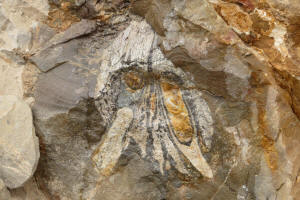Remains of Jurassic sea predator found in Chile's Atacama desert
 Send a link to a friend
Send a link to a friend
 [September 28, 2020]
By Natalia A. Ramos Miranda [September 28, 2020]
By Natalia A. Ramos Miranda
(Reuters) - Scientists have unearthed the
remains of Jurassic sea predators resembling killer whales in the
world's driest desert in Chile.
Pliosaurs were reptiles from about 160 million years ago with a more
powerful bite than Tyrannosaurus rex, according to University of Chile
researchers. The fossils are the second oldest record of this species in
the Southern Hemisphere.
Chile's vast Atacama desert, once largely submerged beneath the Pacific
Ocean, is now a moonscape of sand and stone with parts untouched by rain
for years. Pliosaurs reined the region, with their large skull,
elongated face, short neck, menacing teeth on a hydrodynamic body and
fin-like limbs.

Scientists found jaw, tooth and limb fragments of the creatures
"ecologically similar" to killer whales at two sites in the Loa river
basin near the mining city of Calama.
The find helps scientists fill gaps in evolution, said Rodrigo Otero, a
University of Chile paleontologist who led the research.
[to top of second column]
|

A view of fossil remains of one of the largest and most fearsome
marine predators of the Jurassic period found by scientists in the
middle of the Atacama desert, Calama, Chile December 16, 2018.
Picture taken December 16, 2018. Mauricio Castro/Handout via REUTERS

The complete fossil, under excavation since 2017, is likely to
measure six to seven meters (19.7 to 23 feet). The skull is around a
meter (3.3 feet) long, with teeth each around eight to 10
centimeters (3.1 to 3.9 inches) long, Otero said.
The study was published in the Journal of South American Earth
Sciences in early September.
(Reporting by Natalia Ramos; Writing by Dave Sherwood; Editing by
Richard Chang)
[© 2020 Thomson Reuters. All rights
reserved.] Copyright 2020 Reuters. All rights reserved. This material may not be published,
broadcast, rewritten or redistributed.
Thompson Reuters is solely responsible for this content. |